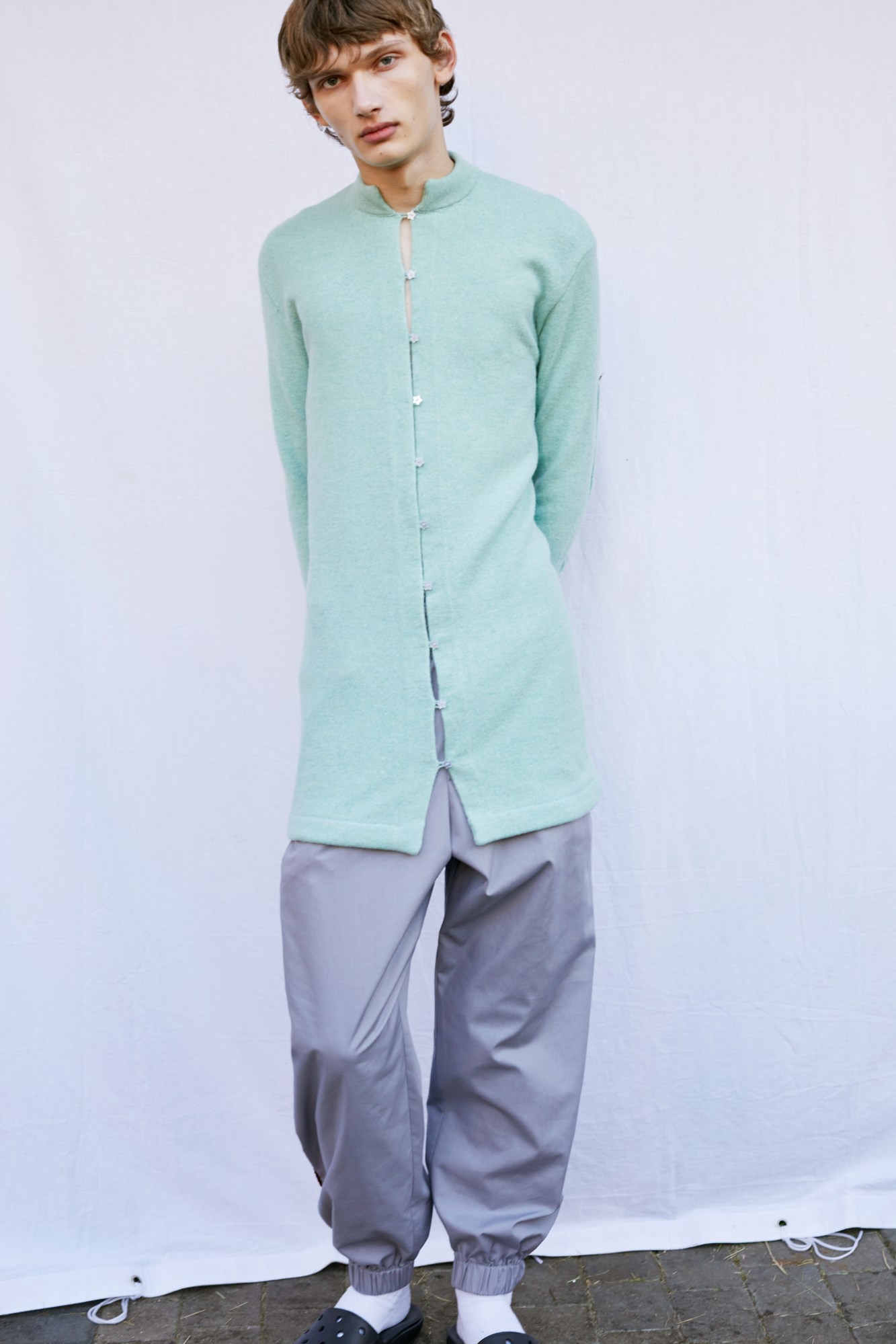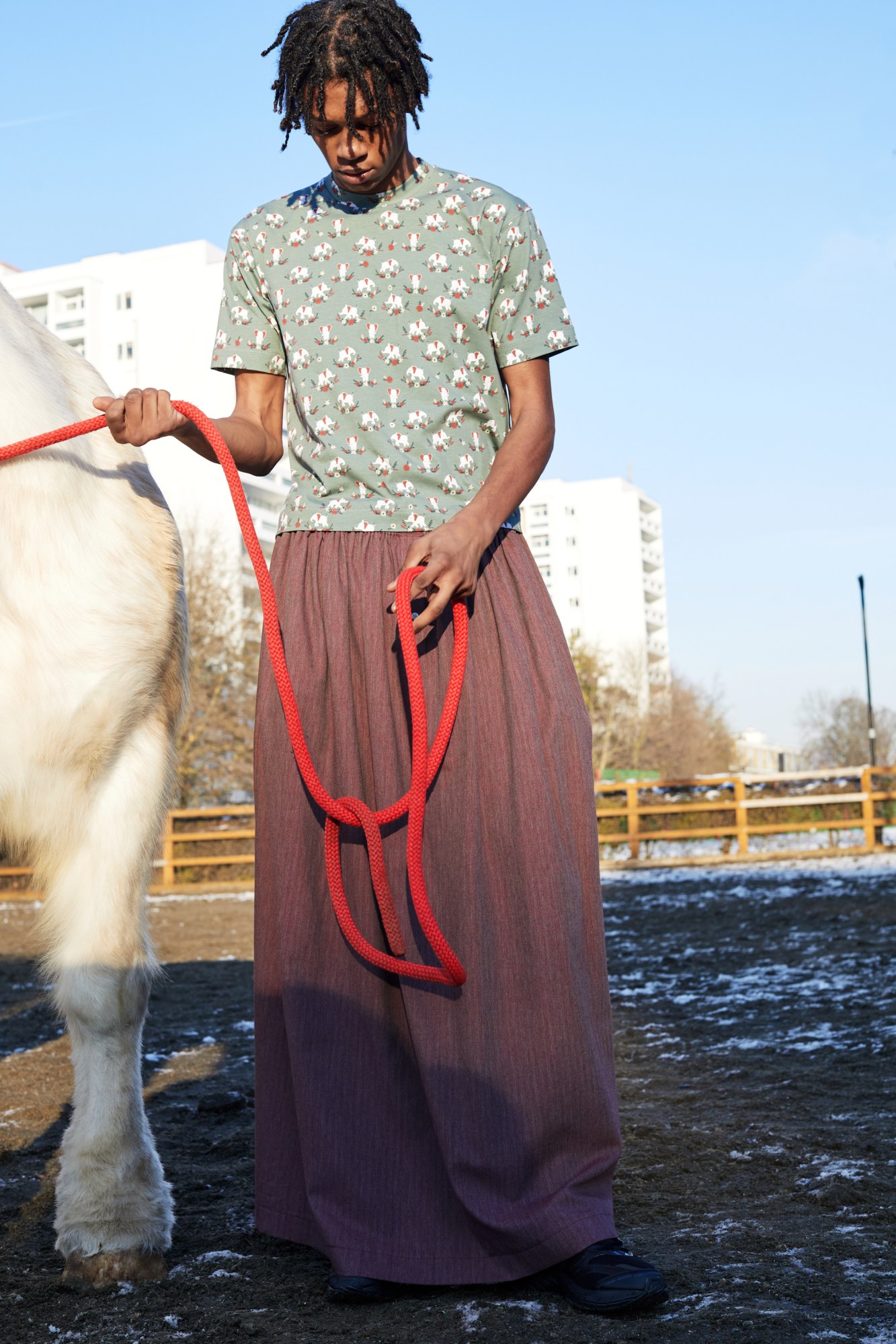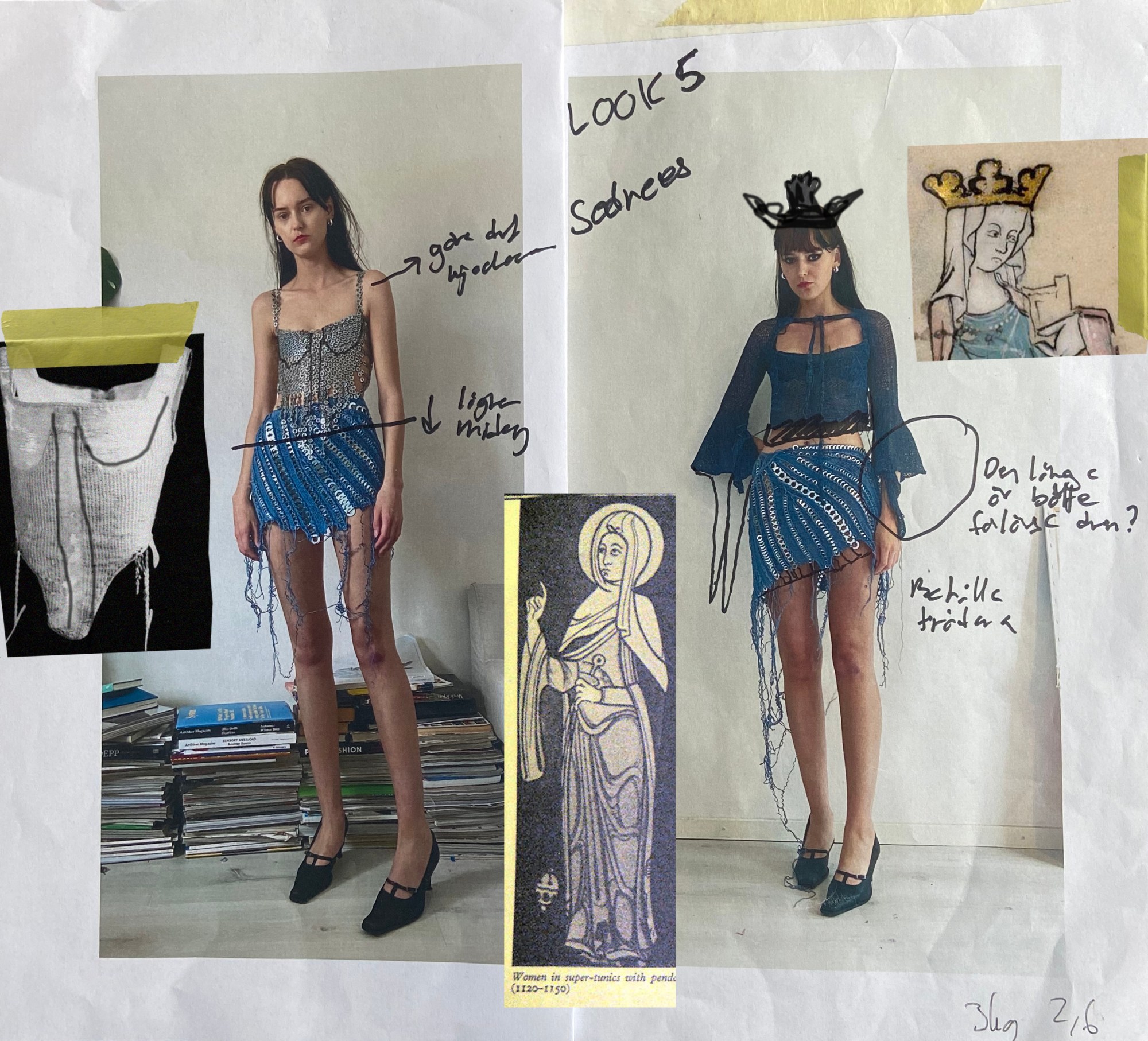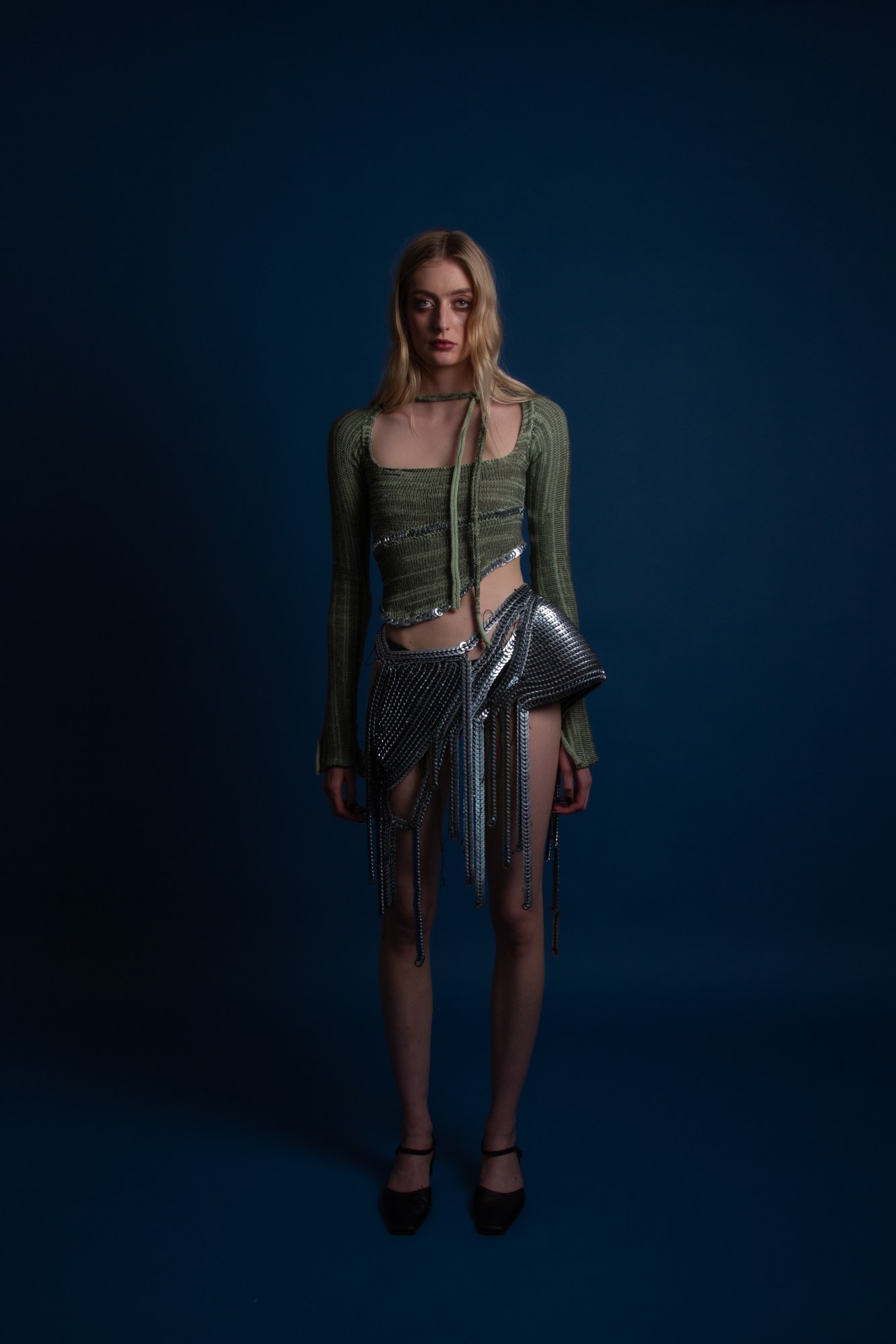Since around last September, the streets of New York and London have looked like a veritable Medieval Fayre, rife with tall-collared doublets, lace-up bodices, and A Knight’s Tale-esque corsets. The zeitgeist’s fascination with all things medieval, however, is nothing new. Think back to House of the Dragon, the television event of the fall; or Lapvona, Ottessa Moshfegh’s depraved chronicle of a fictional medieval fiefdom and, somehow, one of 2022’s buzziest best-sellers. Looking back a bit further, you might remember Balenciaga’s AW21 brigade of ‘chevalier’ footwear. For the last year or so, it seems, the cultural consciousness has been caught up in medieval times, it’s relics and regalia not just influencing the shows we watch or the books we read, but the clothes we’re wearing now.
“Bardcore” (a name borrowed from yet another of the zeitgeist’s medieval fascinations) arrives on the tail of a number of TikTok-powered trends like cottagecore, and the more recent swampcore, angelcore and balletcore. While the Gen Z aesthetic may have begun on the streets, this season, it’s making its way to the runways. At NYFW, Rodarte sent a coven of houppelande dresses, all witchy sleeved, down the catwalk. In London, Wales Bonner showed a crocheted surcoat, amidst a line-up of tunic-style layers. Independent designers including London’s Chloé Nardin and Sweden’s Mikåela Martensson (better known by her alias Mega Mikaela) are also creating nostalgic, fantastical garments inspired by the Middle Ages: the knights in shining armour, the princesses — and the plagues — of yore.


Formerly a model and now a freshly-minted CSM grad, designer Chloé Nardin launched her namesake menswear label for the SS22 season with a collection of buoyant, boyish menswear that would immediately establish her very singular design language. “I’m drawn to creating work that looks at pop and urban culture from a very tender perspective,” she says. “My garments are very relaxed and sporty, yet have this feel of the homemade theatre clothes your mom used to make.” Chloé trades in nostalgia, and that’s exactly what drew her to the Middle Ages for her sophomore offering. Titled Guts, the designer’s AW22 collection takes both its name and its conceptual cues from medieval-themed manga Berserk, which Chloé lovingly refers to as “a knight’s tale”. “I refer to childhood a lot in my work,” she says. “The ‘knight’s tale’ is a great theme as it touches on incredibly serious things like war, domination and power, yet is so charged with nostalgia — so pure in a sense.”
Chloé drew on the duality of knighthood while conceptualising and patterning her AW22 garments. The designer’s initial research saw her diving into the realm of medieval military costume, gear made for mobility, utility and… well, war. Chloé’s goal was to bring some of that signature tenderness to these traditionally — and very aggressively — masculine costumes. She notes that most medieval clothes were fashioned from wovens or leathers, the stretch fabrics we know and wear today were still centuries from existence. “If you look at it chronologically, garments have only become more and more elastic, softer in a sense. A lot of what I do is exactly that, in a more or less literal way. In the case of this collection, I would take inspiration for a shape from, for example, a military jacket, and make it out of knit – softening it.” Guts is rife with these kinds of gentle subversions: a cotehardie knitted in seafoam lambswool and finished with star-shaped buttons becomes a cozy cardigan; skirts (cut to mimic longer, ankle-length tunics) are trimmed with ruffled hems and rendered in soothing palm prints. “Fashion in the Middle Ages is, to me, particularly interesting as it conveys notions of romanticism and grandeur, while being quite minimal,” she says. With her AW22 collection Chloé taps into that romance and dials it up — ever so gently! — to 10.

Mikaela approached the medieval with a similarly rosy vision. “My aesthetic has a foundation in a romanticised world but with an irate attitude,” says the knitwear designer and Swedish School of Textiles grad. “I’m fascinated by the figures of the princess, the angel and the fairy, but I also relate to evil characters like the witch and the devil. Really, it’s probably about the complexity of being human.” These kinds of storybook tropes are what initially drew the designer to the Middle Ages and, likely, what drew Caroline Polachek to Mikaela’s designs for her 2022 tour. “I’m interested in the dissimilarity between the escapist fantasy of knights and princesses in contrast to the awful realities of plague and famine,” says the designer. “There was a lot of misery during the Middle Ages.”
Titled Lovely Misery, her SS23 offering serves to romanticise the era’s wretchedness, dressing up its traditional garments — the hennin (a high cone-shaped headdress), the tippet (a streamer-like arm ornament) and the ubiquitous chainmail body armour — with modern techniques, materials and cuts to forge a new narrative. Mikaela knits most of her garments on domestic machines, however, her chainmail garments are hand-crocheted with just a needle, some yarn, and “a lot” of metal washers. (At the moment, the designer has bought up the entire Swedish stock). “For me, it’s important to bear the touch of the hand,” she says. On Instagram, the caption to one of her metal pieces echos this sentiment: “Love through handicraft,” it reads. While Mikaela’s knitted chainmail pieces — slinky, Y2K-esque dresses and miniskirts — are marvellous feats of handicraft, they’re also incredible sexy. Talk about the transformative power of tenderness.


The collection’s final look, according to Mikaela, is its crowning glory. “The Plague Dress has the look and feeling of evil and death, but takes the shape of a princess gown,” Mikaela says. Knitted in a rather gruesome shade of red, the gown spirals and circles the body, traveling around and down, and ending in a heap of shredded threads and frayed ribbons at the wearer’s feet. “I wanted the dress to look like a disease taking over a person; slowly killing them through organic lines embracing the body.” A little grim but that’s the Middle Ages for you.
SUBSCRIBE TO I-D NEWSFLASH. A WEEKLY NEWSLETTER DELIVERED TO YOUR INBOX ON FRIDAYS.
Our current infatuation with all things medieval though, may well have arisen from the relative grimness of our own times. After all, the lineage of our current fixation is most easily traced back to modern society’s recent brush with mass death due to the pandemic (our own plague, if you will), coupled with lockdown-living and exacerbated by the increasingly isolating nature of algorithm-driven online spaces. To all of that, however, Mikaela brings some levity: perhaps we’re looking to the medieval “for an escape to the world of fairytales; a need to romanticise awful things”.


